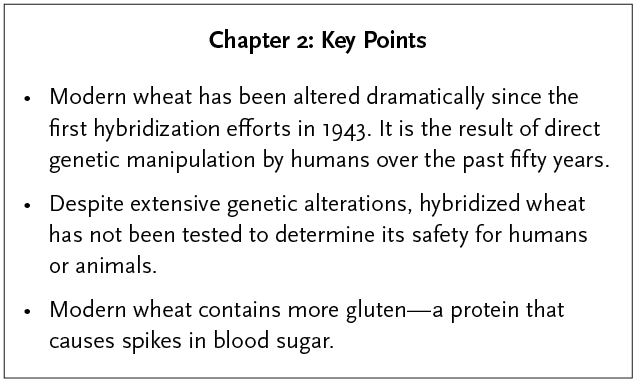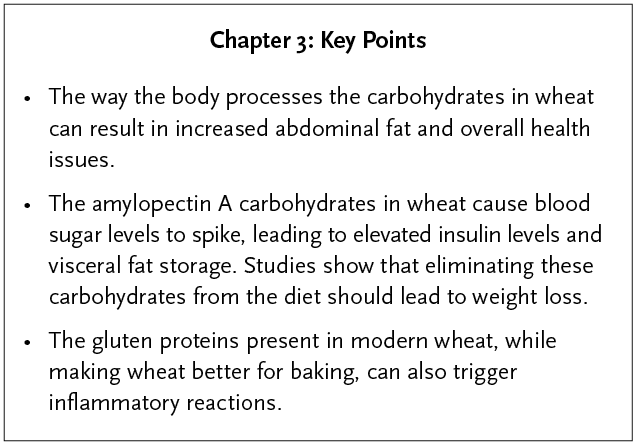Summary: Wheat Belly ...in 30 Minutes (2 page)
Read Summary: Wheat Belly ...in 30 Minutes Online
Authors: 30 Minute Health Summaries


NOT YOUR GRANDMA'S MUFFINS: THE CREATION OF MODERN WHEAT
Overview
From bread to breakfast cereal to pasta, wheat accounts for 20 percent of all calories consumed on earth. But wheat has been genetically altered to such a degree that modern wheat bears very little resemblance to the original einkorn wheat our ancestors ate ten thousand years ago. While these alterations have increased yield and decreased production costs, they have also created modern strains of wheat that may be difficult for humans to digest and harmful to our health.

“Modern wheat, despite all the genetic alterations to modify hundreds, if not thousands, of its genetically determined characteristics, made its way to the worldwide human food supply with nary a question surrounding its suitability for human consumption.”
â Dr. William Davis,
Wheat Belly

Chapter Summary
Wheat was first harvested by the Natufians around 8500 b.c. to supplement their hunter-gatherer diet. This ancestor of modern wheat, einkorn, was much different genetically than its modern equivalent; most notably it had a simple genetic code with only fourteen chromosomes. Einkorn crossed with a wild grass yielded emmer, the wheat that was around in biblical times. Emmer was eventually crossed with another natural grass, yielding
Triticum aestivum
â a complex wheat containing forty-two chromosomes that was genetically easy to manipulate.
Fifty years ago, intense manipulation began. Modern wheat is descended from strains created at the International Maize and Wheat Improvement Center, an agricultural research program developed to increase the yield of soy, corn, and wheat, and thus reduce world hunger. Founded in
1
943, this program hybridized, or crossbred, existing strains of wheat. By
1
980, it had created thousands of strains of wheat that, thanks to human intervention, were hundreds of genes apart from the original einkorn wheat.
No safety testing was ever done on these hybrid crops. It was simply assumed that since the wheat was still a form of wheat, it would be safe. But analysis of the proteins in modern hybrid wheat found that while about 95 percent of the proteins expressed in the offspring are present in both the parent strains, 5 percent are unique and are found in neither parent. So what we know about the safety of the parent strains may or may not be true of the hybrid strains.
In addition, modern wheat
(Triticum aestivum)
expresses a higher number of genes that make gluten proteins. Gluten makes bread more stretchy and pliable, and makes it rise more. But it comes at the cost of causing greater blood sugar spikes.

“Small changes in wheat protein structure can spell the difference between a devastating immune response to wheat protein versus no immune response at all.”
â Dr. William Davis,
Wheat Belly



WHEAT DECONSTRUCTED
Overview
What kinds of carbohydrates you eat are even more important than how many. Carbohydrates that are more easily and rapidly digested create spikes in blood sugar, causing the body to make more insulin. The spikes are followed by crashes that leave us hungry. Wheat is high in a type of carbohydrate that is very efficiently digested, causing it to have the same effect on the body as candy or sugary soda drinks. The repeated spikes in blood sugar and increased insulin production promote fat storage and can lead to diabetes. Davis suggests that following a wheat-free diet will lead to lower blood sugar levels and less incidence of obesity and diabetes.

“[W]heat products elevate blood sugar levels more than virtually any other carbohydrate, from beans to candy bars. This has important implications for body weight, since glucose is unavoidably accompanied by insulin, the hormone that allows entry of glucose into the cells of the body, converting the glucose to fat.”
â Dr. William Davis,
Wheat Belly

Chapter Summary
Wheat is a complex carbohydrate, meaning it is composed of repeating chains of glucose (simple carbohydrates like processed sugar are made of just one or two chains of glucose). Conventional wisdom says complex carbs are better for you because they break down more slowly in the digestive tract.
But modern
Triticum aestivum
wheat contains a very easily digestible form of these complex carbs called amylopectin A. These carbs are more efficiently converted to blood sugar than most other carbs, simple or complex. So when you look at how quickly and efficiently whole wheat bread breaks down into glucose, it's about the same in your body as a can of soda. You just get more fiber from the whole wheat.
Amylopectin A, because it is digested so efficiently and quickly, induces a blood glucose peak that lasts about two hours, followed by a crash as glucose levels drop. Insulin levels increase as glucose levels rise, because insulin is required to metabolize glucose. This glucose-insulin cycle acts as an appetite stimulant, and also causes the body to store more visceral fat. Stored visceral fat causes a poorer response to insulin, causing the body to require higher and higher levels of insulin â a situation that sets you up for diabetes.
The other problem with wheat is gluten. Glutens are the storage proteins in wheat, and are what make it stretchy and easy to rise. Hybridized wheat has been engineered to increase the types of glutens that make wheat good for baking. But these types of glutens also tend to provoke inflammatory and allergic responses in the body.

“The bigger your wheat belly, the poorer your response to insulin, since the deep visceral fat of the wheat belly is associated with poor responsiveness, or âresistance,' to insulin, demanding higher and higher insulin levels, a situation that cultivates diabetes.”
â Dr. William Davis,
Wheat Belly


